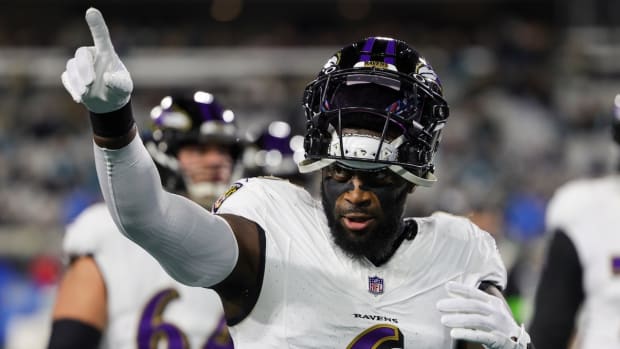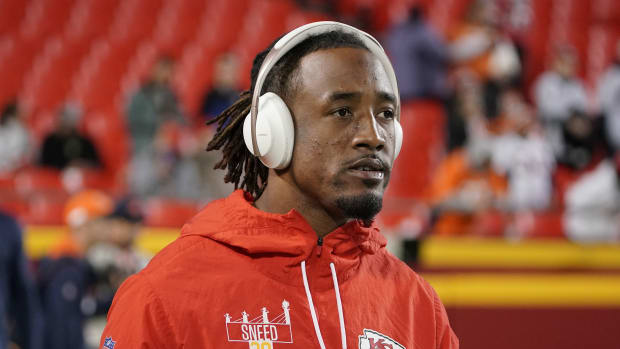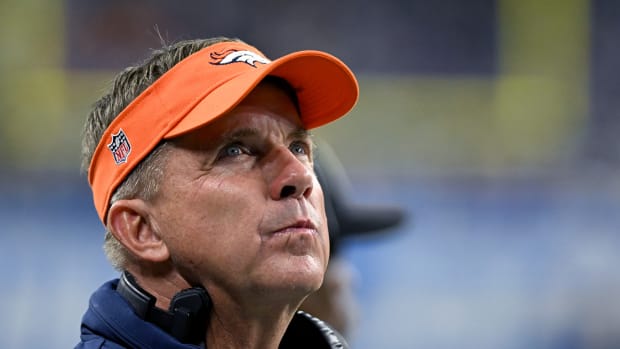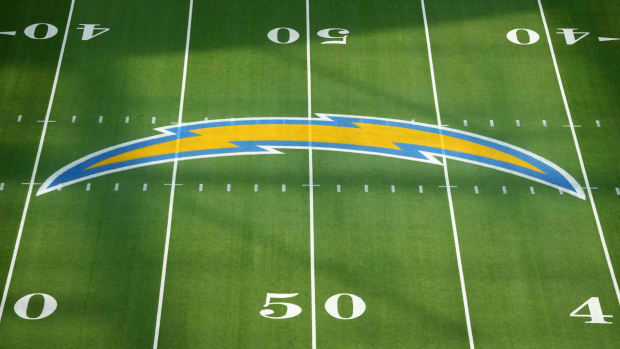Draft Projections: AFC East
From l. to r., Miami’s Clive Walford, Oregon’s Marcus Mariota, Florida State’s Eddie Goldman and Washington’s Shaq Thompson. (AP :: SI :: Icon Sportswire :: Getty Images)
BILLS’ PROBLEMS
By Andy Benoit
New Buffalo coach Rex Ryan runs a very different defense from the one installed by last year’s coordinator, Jim Schwartz, whose contract was terminated in January. Ryan’s D is 3-4–based with an emphasis on blitzing and disguise. Schwartz’s was zone-based and tilted toward simplicity. The Bills ranked fourth in points and yards allowed under Schwartz, but that doesn’t mean they won’t prosper under Ryan. Recall that this D performed well two years ago under Mike Pettine, a Ryan protégé who used a lot of the same blitz concepts.
The Bills have the man-coverage corners to make those blitzes work; they actually have the talent to make any scheme work. In an effort to preserve that talent, GM Doug Whaley must strive to re-sign FS Da’Norris Searcy and especially DE Jerry Hughes, the former Colts first-rounder who originally shook the “bust” label playing outside linebacker under Pettine.
• MORE ON THE DRAFT: Andy Benoit goes deeper into the AFC East on The MMQB Podcast
Buffalo’s remaining needs are on offense, starting at quarterback. Contrary to the rampant speculation, it’s highly unlikely that Doug Marrone was the reason that E.J. Manuel failed to develop. The third-year QB is methodical in too many facets. You couldn’t blame the Bills if they jumped at an opportunity to get someone new. The recent signing of guard Richie Incognito could bring the additional stability that the interior offensive line needs. Then again, Incognito has been out of football for a year and a half. The last area to address: tight end. Scott Chandler is in a contract year, and though he’s good at catching balls in traffic, he’s not a weapon defenses must plan to stop. A dynamic tight end would really boost new coordinator Greg Roman’s system—and aid whomever is at quarterback.
BILLS’ SOLUTIONS
By Andy Staples
If the Bills want to find a quarterback who might take EJ Manuel’s job, they may have to spend their first pick on that player. The free-agent quarterback market isn’t great, and the quarterback group in this draft class is fairly thin behind Florida State’s Jameis Winston and Oregon’s Marcus Mariota—both will be long gone by the time the Bills select at No. 50. (Remember, they gave away their 2015 first-rounder in last year’s trade so they could move up and select Sammy Watkins.) That means if they want UCLA’s Brett Hundley or Baylor’s Bryce Petty, they probably have to use that second-rounder.
The 6-3, 227-pound Hundley seems to have all the physical tools, and he’s a smart guy who should represent a team very well off the field. But he never developed into a polished passer in three years as the starter at UCLA. If this sounds an awful lot like E.J. Manuel coming out of Florida State, it should (although Manuel only started for two years in Tallahassee). Petty represents a different kind of risk. He’s a freakish athlete with a strong arm, but Baylor’s offense isn’t like any in the NFL. This is like taking a motivational speaker who to this point has always spoken French and asking him to deliver the same message in Russian and expecting similar results. He might have the aptitude to make the transition easily, or he might not. Petty has been studying NFL protections and route trees since last year, so he knows how much work he must do to adjust to NFL schemes.
If the Bills decide against drafting a quarterback early, they might be able to grab their tight end at No. 50. Clive Walford, a versatile 6-4, 258-pounder who led Miami in catches (44) and finished second on the team in receiving yards (676) could still be available. Buffalo might then be able to pick up a pass-rushing outside linebacker in the third round. There are no perfect prospects at this point. Washington’s Hauoli Kikaha led the nation in sacks with 19, but how many of those came because defensive tackle Danny Shelton—who probably will be drafted in the first round—occupied two or three blockers? Like Kikaha, Louisville’s Lorenzo Mauldin was a defensive end in college but could be athletic enough to be a quality outside linebacker in the NFL.
Buffalo has two fifth-round picks. If he’s still available, the Bills may want to consider picking up Yale back Tyler Varga. He can play tailback or fullback, and his ability to catch the ball out of the backfield could allow him to play an H-back role. Varga is the type of guy Stanford loved to use when new Buffalo offensive coordinator Greg Roman worked there.
DOLPHINS’ PROBLEMS
By Andy Benoit
Mike Wallace deserves to be cut. He’s an overpaid malcontent. Problem is, cutting Wallace now would create $9.6 million in dead money versus just $2.5 million in cap savings. A more likely receiver for the chopping block is Brian Hartline, who was average at best last year in new coordinator Bill Lazor’s scheme. Hartline would carry $4.2 million in dead money but a $3.15 million cap savings.
It’s possible neither receiver gets replaced. That wouldn’t be ideal, but there were greater woes on offense last year—namely pass protection. If left tackle Branden Albert comes back strong from a midseason ACL injury, 2014 first-rounder Ja’Wuan James can move back to right tackle, where he’s better suited. That would leave guard as the only position of need. If Dallas Thomas, who filled in at right tackle after Albert’s injury last season, moves back to that spot and Mike Pouncey returns to center, the Dolphins would need only one guard. If it doesn’t go that way, they’d likely need at least one guard and a center. One option would be re-signing veteran Samson Satele, who filled in decently there last season.
On the other side of the ball, general manager Dennis Hickey must consider adding to a linebacking corps that is good but not great. Miami’s run defense faltered down the stretch last year (again). Flexible base defensive end (and nickel defensive tackle) Jared Odrick is a must re-sign. Lastly, with Louis Delmas and Jimmy Wilson both free agents, the Dolphins need to restock in the defensive backfield.
DOLPHINS’ SOLUTIONS
By Andy Staples
The Dolphins can address one of three needs at No. 14—cornerback, offensive line or linebacker. The key is figuring out which two of the three might possibly be addressed later in the draft. At the moment, Miami has one pick in each of the seven rounds.
Some quality guards can be had in the second and third rounds, so the Dolphins should hold out and see if they can grab Duke’s Laken Tomlinson or Florida State’s Tre Jackson. Meanwhile, a team willing to take a chance might strike gold at cornerback in the second, third or fourth rounds. USC’s Josh Shaw is 6-1 and can play cornerback or safety, but he may be available later in the draft because some teams may not be able to look past that whopper he told in August. LSU’s Jalen Collins is another tall (6-2) corner, but he suffers from a lack of meaningful experience. He could grow into a dominant coverage guy, or he might not. That’s the risk, but he has a lot of the physical tools.
So that leaves linebacker for the first round. Given defensive coordinator Kevin Coyle’s willingness to play a wide variety of fronts based on personnel matchups, there should be plenty of intriguing options. Coyle likes Swiss Army Knife players, and Washington’s Shaq Thompson is precisely that. He is athletic enough to play linebacker or safety. He can cover. He can make plays against the run. He can rush the passer. Heck, he can even rush with the ball. When Washington was thin at tailback during the 2014 season, coach Chris Petersen played Thompson there. He carried 61 times for 456 yards and two touchdowns. He’s that kind of athlete.
PATRIOTS’ PROBLEMS
By Andy Benoit
Darrelle Revis is due to count $25 million against the cap, which means the only way he stays in New England is through a new (and likely long-term) deal. Even if young stud receivers Dez Bryant, Demaryius Thomas and Randall Cobb make it to the open market and defensive tackle Ndamukong Suh is out there, a soon-to-be 30-year-old Revis would be the most valuable player available, particularly for man-based defensive teams such as New England. Revis’s ability to individually shut out No. 1 receivers changes how the rest of a defensive backfield approaches the game. Without Revis, Bill Belichick and Tom Brady wouldn’t have a fourth Super Bowl ring.
Another important DB to re-sign is Devin McCourty. Premium range and versatility should earn him top dollar among free safeties not named Earl Thomas.
Offensively, the interior line is adequate, but only adequate. Its most veteran member, Dan Connolly, is unsigned. The decision of whether to bring him back will depend heavily on the price tag. In the backfield, Shane Vereen—perhaps the best receiving back in football—is more important to re-sign than Stevan Ridley, who’s coming off an ACL injury. Vereen brings critical dimension to two-tight end packages. People love to degrade the Patriots’ wide receivers, and perhaps finding a new one wouldn’t be the worst thing. But for how Josh McDaniels’s and Brady’s offense operates, Vereen is a greater priority.
PATRIOTS’ SOLUTIONS
By Andy Staples
The Patriots have picks in every round except No. 5, and they have two fourth-rounders. One is the second pick of the round, which came from the Buccaneers in the Logan Mankins trade. This might be a great spot to pick up another speedy slot receiver who catches everything if East Carolina’s Justin Hardy remains available.
Assuming Bill Belichick doesn’t trade No. 32 and turn it into 17 more picks over the next seven years, Florida State defensive lineman Eddie Goldman is an intriguing selection here. Goldman doesn’t look like he weighs 320 pounds, but he does. He’s quick enough to play defensive end in a 3-4, but he also might be able to carry more weight and play nose. He holds his ground well, and Vince Wilfork can’t play forever.
If McCourty can’t be re-signed, the Patriots might be able to find a free safety lower in the draft. Michigan State’s Kurtis Drummond seems like the kind of player Belichick loves to mine in the middle rounds. Drummond played in an excellent program for a brilliant coordinator (Pat Narduzzi), and Drummond was relied upon this season to be the coaching staff’s eyes and ears on the field.
JETS’ PROBLEMS
By Andy Benoit
Todd Bowles is going to have a very tough go of it in his first season as a head coach. In Arizona, Bowles ascended to the top of defensive coordinator ranks by orchestrating one of the most aggressive, pressure-oriented schemes the NFL has seen. He could be creative because he had two excellent man-to-man corners (Patrick Peterson and Antonio Cromartie). In New York, Bowles inherits zero quality corners. With the thoroughly mediocre Kyle Wilson (2010 first-round pick) unlikely to be re-signed, the Jets have vacancies at their top three cornerback spots.
There’s a decision to be made about linebacker David Harris. The 31-year-old is stout, and even spectacular at times. The question is whether his price is justified in a scheme that could often employ one linebacker and three safeties. In that package, the more athletic Demario Davis would get the playing time instead of Harris.
Speaking of safeties, the Jets could use an upgrade there, too. First-rounder Calvin Pryor struggled as a rookie. Jaiquawn Jarrett and Antonio Allen, who moonlighted at corner last season, are very average. So is Dawan Landry, who is unsigned.
Incredibly, New York’s offense is even more tattered. Quarterback is considered a big need, though despite what fans and media think, there’s a debate to be had on whether giving up so soon on Geno Smith is the right thing. Most likely, new GM Mike Maccagnan, who has no stake in Smith, will do just that. Whomever they put at quarterback will be handicapped by an ineffective receiving corps, assuming upgrades aren’t made. Up front, the O-line has problems at guard, where soon-to-be 32-year-old Willie Colon is a free agent and 2013 third-rounder Brian Winters has so far not panned out.
JETS’ SOLUTIONS
By Andy Staples
If the quarterback the first-pick Buccaneers don’t take is available at No. 6—either Mariota or Winston—the Jets need to grab him. If not, then perhaps Alabama safety Landon Collins would provide Todd Bowles with the versatility he craves at that position.
The Jets pick again at No. 37, and this could be a good spot to grab a receiver. They may have a shot at either Auburn’s Sammie Coates or Arizona State’s Jaelen Strong here. Both are big—Coates is 6-2, 213, and Strong is 6-3, 215—while still being capable of stretching a defense. Coates will put up some freakish speed and vertical jump numbers at the combine, and it will be interesting to see how much better he performs with an NFL quarterback throwing the ball. Remember, Coates had Nick Marshall (who will play cornerback at the next level) throwing him the ball in college. Strong already has put a ton of highlights on tape. He’s an absolute nightmare against man coverage.
Follow The MMQB on Facebook, Twitter and Instagram.
[widget widget_name="SI Newsletter Widget”]















































